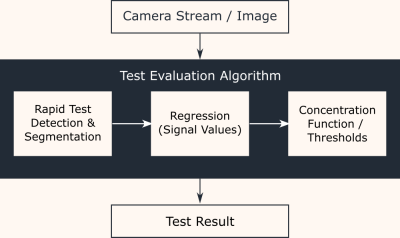Experience efficiency in action
Flowify AI contains a state-of-the-art image analysis algorithm for the evaluation of rapid tests and is based on the analysis of a camera stream, i.e., a sequence of images. The algorithm is designed to run efficiently on mobile devices. It can analyze over 10 images per second and compute test results in real-time.

Image analysis workflow
The general workflow of the algorithm can be described as follows:
1. Input
The input of the algorithm is a camera stream or a single image.
2. Test detection & segmentation
The algorithm detects and segments rapid tests and their components in an image. To ensure high quality test images, various validation checks are employed. The object detection is not limited to specific tests (e.g., test cassette housing) and can be adapted to almost any test with reasonable effort.
3. Regression
After the detection and segmentation of test components, a regression model infers the signal value for each line of a lateral flow assay. The signal value refers to the perceived brightness of a line, i.e., from zero if the line is not visible and approximating one if the line is very dark (e.g., dark red). The regression model is trained on a very large and continuously growing dataset, comprising more than 1 million images.
4. Concentration function / thresholds
The signal values can serve as input for arbitrary concentration functions. For qualitative and semi-quantitative tests, it is possible to set appropriate thresholds.
5. Test result
A result is provided for each test that appears in the image, derived from the computed signal values of each line. The algorithm supports all common result types of lateral flow assays:
- Quantitative
The predicted signal values can serve as input of typical calibration functions (e.g., linear, 4PL, 5PL). For instance, it is also possible to compute the ratio of a test line and the control line or to sum the values of all test lines. - Semi-quantitative
Multiple thresholds have to be set in order to obtain a semi-quantitative result. - Qualitative
A single threshold has to be set to distinguish positive and negative samples.The algorithm also detects if a test result is not valid (e.g., control line not visible).
Additional features
Flowify AI not only computes test results but also guides the user during the scanning process. The software provides recommendations to improve any inadequate capturing situation whenever necessary. It thereby ensure a precise and reliable test result. These recommendations include, for instance, the distance of the camera to the test, as well as overexposure due to the lighting, background surface, or reflections on the test.
The test evaluation module also contains a barcode reader to directly detect identifiers such as e.g., a QR code, a data matrix, or an EAN on the segmented rapid test images. These kind of barcodes on a test can provide information about the product and batch version or even a unique device identifier.
The algorithm is designed to run directly on a mobile device. This poses several advantages:
- The test evaluation does not depend on an internet connection and becomes an accessible solution even in remote areas and settings.
- The resolution of images can remain high and will not be constrained by the quality of an internet connection.
- The design omits any risk of latency in data transfer and positively shapes the usability of Flowify AI.
- Maintaining a scalable infrastructure that does not limit the number of simultaneous scanning processes can be expensive and challenging. These costs can be completely avoided by relying on the computational power of the devices of the end users.
- There is no need to transfer any data about a performed test to a server if data protection is a concern.
- While the test evaluation algorithm is designed to run on mobile devices, it can also be deployed in the cloud and used as an independent software module.
Performance
In corporation with Senova, we performed an extensive performance evaluation of Flowify AI using D-Dimer tests and real capillary blood samples. The results showed a very satisfactory performance with respect to qualitative and quantitative test results.
Qualitative test results. Flowify AI can reliably detect if the test is positive or negative even though most samples were very close to the cut-off of the rapid tests, which means that the test line is hardly visible.
Quantitative test results. Flowify AI computes signal values for each line in an LFA. The evaluation showed a very strong positive correlation with the peak area measured by the established QIAGEN aLF hardware reader. Moreover, also the resulting concentration values after the fitting of a 4-PL function reveal a noteworthy correlation that highlights the precision of the algorithm and the viability of the smartphone as reader device using the Flowify AI mobile application.
Data security & privacy
The services comprised by Flowify AI are compliant with the General Data Protection Regulation.
Moreover, the data concerning a test that is evaluated by Flowify AI does not have to be shared with anyone. The complete evaluation of a test takes place on the device of the user and no data needs to be uploaded to a cloud service. If the data is uploaded to a cloud service, it will be encrypted using state-of-the-art technology.
While the ML-based algorithm is trained using a very large data pool consisting of images of rapid tests, it does not rely on personal information.